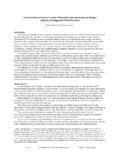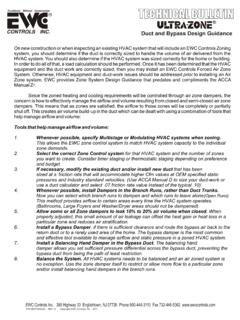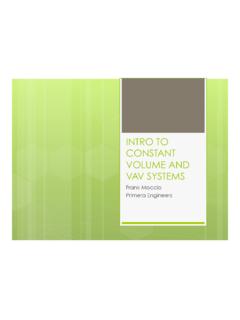Transcription of Some Basics of Duct Design and Installation
1 Retrofitting Existing Ducted SystemsSeptember 2003 Rick Karg, Karg Associates1 Retrofitting ExistingRetrofitting ExistingDucted SystemsDucted SystemsGasNetworks HVAC Heating Professionals Fall ConferenceSeptember 18, 2003 2003 Karg AssociatesRick Karg Existing Ducted SystemsTopics Addressed in Session Ductwork sizing discussion. Ductwork Specification: Consortium for Energy Efficiency (CEE). Tools for duct Design and commissioning. Some duct Installation details. Analysis of existing ductwork. Ductwork Existing Ducted SystemsSome Basics of duct Some Basics of duct Design and Design and InstallationInstallation4 Retrofitting Existing Ducted SystemsDucted DistributionSee Handout 2, Page 15 Retrofitting Existing Ducted SystemsGood Ducts Start With Good Design Design - yeah, right!
2 What constitutes Design is usually a mix of after-thought, what happens to be on the truck at the moment, and the need to get the job done Existing Ducted SystemsDuct Design Objective duct delivery system provides year-around comfort with: Efficiency, Little noise, No hazards to occupants, Little Existing Ducted SystemsSeptember 2003 Rick Karg, Karg Associates27 Retrofitting Existing Ducted SystemsA Well Designed duct System Properly balanced. Look good. Be inexpensive to install. Help create a comfortable environment. Be very quiet while air handler is operating. Be economical to operate.
3 Proper insulation, tight ducts, no pressure imbalance. Be healthy for occupants ( , from pressure imbalances). Be easy to Handout 2, Page 28 Retrofitting Existing Ducted SystemsLow Noise Levels are Important9 Retrofitting Existing Ducted SystemsDuct Design Rules Place air handler in central location. Plan for symmetrical duct system. Keep duct runs short. Support ducts properly. Use minimum number of fittings. Keep aspect ratio low. Select registers properly. Install return in each room having a working door. Handout 2, Page 310 Retrofitting Existing Ducted SystemsDuct System PressuresSee Handout 2, Page 411 Retrofitting Existing Ducted SystemsMeasuring Temperature Rise &Calculating CFMSee Handout 2, Page 512 Retrofitting Existing Ducted SystemsDesign Standard is Manual DAvailable from ACCA2800 Shirlington Road, Suite 300 Arlington, VA 22206(703) Existing Ducted SystemsSeptember 2003 Rick Karg, Karg Associates313 Retrofitting Existing Ducted SystemsManual D Procedure Calculate DHL/DCL (Manual J,ACCA).
4 Select blower (Manual S,ACCA & Man. Data). Determine External static Pressure (ESP) from manufacturer s data. Determine device pressure losses (DPL) that are added to distribution system. Determine Available static Pressure (ASP). ASP = ESP DPL (Equal to about WG, limits of range are to WG).See Handout 2, Pages 6 - 1014 Retrofitting Existing Ducted SystemsManual D Procedure (con.) Plan location of registers and grilles (Manual T). Determine the greatest Total Effective Length (TEL) value for the duct system, supply and return sides. Include measured length and fitting equivalent length.
5 Calculate Friction Rate Design value (FR). FR = (ASP x 100)/TEL, or use friction chart. Friction rate should be between and WG/100 feet of Handout 2, Pages 6 - 1015 Retrofitting Existing Ducted SystemsManual D Procedure (con.) Calculate heating and cooling airflow factors. HF = (blower CFM)/( Design heating load) CF (blower CFM)/(Sensible cooling Design load) Calculate CFM for each register (room). Room CFM = HF or CF x Room DHL Size branch ducts and trunks with use of duct calculator or friction chart. Check velocity. Select registers and grilles (Manual T, ACCA).
6 Balance system with branch balancing Handout 2, Pages 6 - 1016 Retrofitting Existing Ducted SystemsDuctwork Specification 1 Quick Reference for HVAC Installation Specification Ducts and Air Handlers Section/Specification Element Specification Element Potential Benefits Verification Test or Method 5. Ducts and Air Handlers duct Location - All ducts should be located within the conditioned spaces whenever possible. - No ducts in exterior wall cavities. - Always install ducts, don t use building cavities. - No panned floor joists. - Don t use crawl spaces as plenums.
7 - Reduces conduction and air-leakage losses. - Visual inspection. duct System Design - Use Residential duct System, Manual D, 1995 edition or later. - If ducts are not sized large enough to permit adequate airflow, system efficiency can be adversely affected. - Residential duct System, Manual D, 1995 edition or later. Allowable duct Leakage, New Air Distribution Systems - 25 CFM of leakage for every 400 CFM of measured airflow, or - The sum of supply and return leakage divided by air handler fan flow shall be a maximum of 6%. - Can save 15% in energy costs per year for new systems.
8 - Tests for Ensuring Proper Air Handler Airflow and - Total duct Leakage and Percentage duct Leakage Test Allowable duct Leakage, Existing Air Distribution Systems - 40 CFM of leakage for every 400 CFM of measured airflow, or - The sum of supply and return leakage divided by air handler fan flow shall be a maximum of 10%. - Can save 10% in energy costs per year for existing systems. - Tests for Ensuring Proper Air Handler Airflow and - Total duct Leakage and Percentage duct Leakage Test duct Sealing Materials and Methods - Refer to duct Installation and Sealing Specification.
9 - Use of the proper materials and methods extends the life of the ducted system, retaining duct efficiency. - Visual inspection. Insulation, New and Existing Installations - Follow insulation manufacturer s recommendations. - Refer to duct Installation and Sealing Specification - duct insulation slows heat transfer, making the ducted distribution network more efficient. - Visual inspection. Insulation, New Installations - No insulation required for ducts in conditioned spaces, except to prevent condensation. - In unconditioned spaces a minimum R-value of 6 is required.
10 - Ducts located on the exterior of building require a minimum R-value of 8. - duct insulation slows heat transfer, making the ducted distribution network more efficient. - Visual inspection. Insulation, Existing Installations - No insulation required for ducts in conditioned spaces, except to prevent condensation. - In unconditioned spaces a minimum R-value of 6 is required. - Parts of ductwork that are not accessible do not require insulation. - If ducts are already insulated to R-4 or greater, no additional insulation is needed. - Ducts located on the exterior of building require a minimum R-value of 8.













